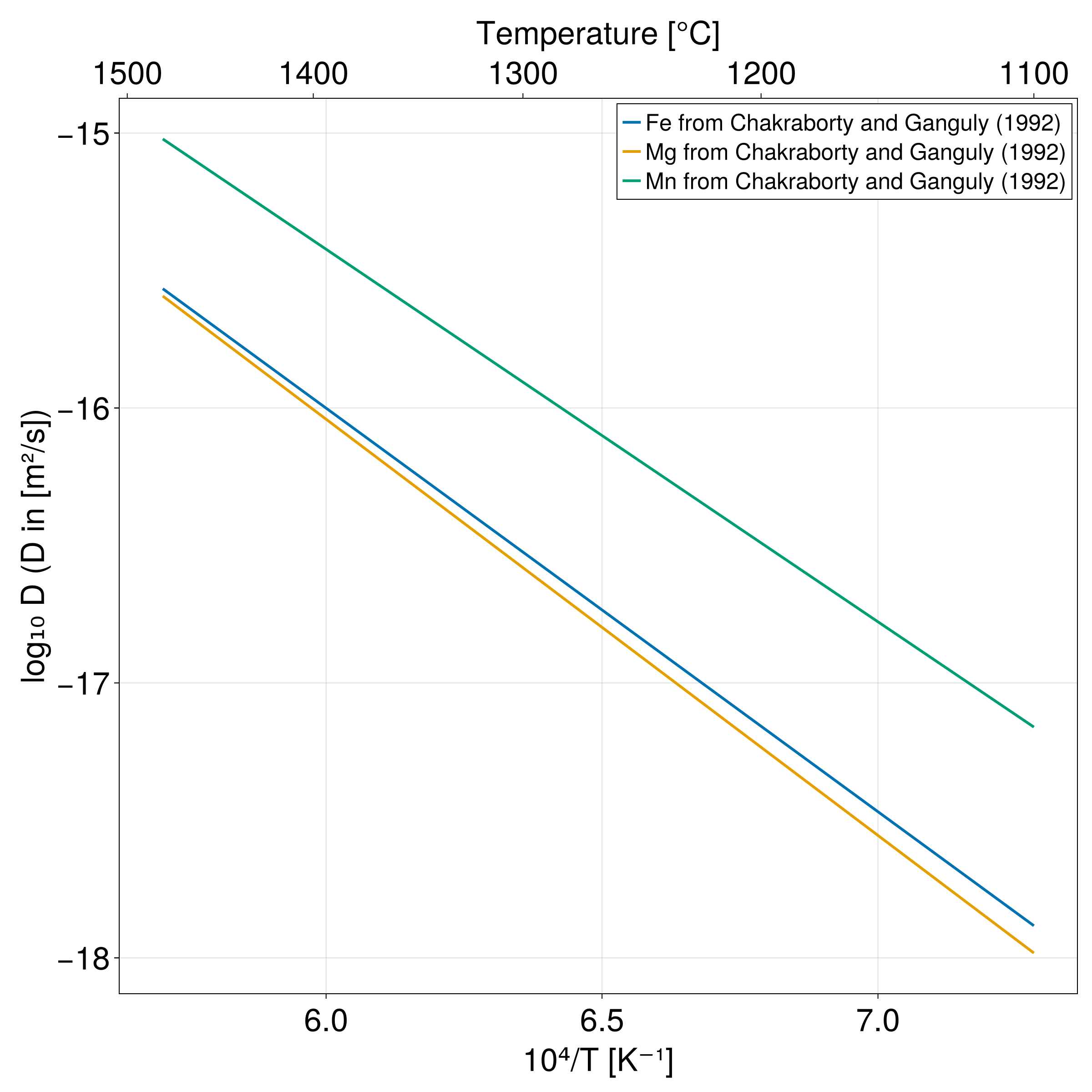Chemical Diffusion
Some routines and experimental data to compute chemical diffusion coefficients in minerals and phases are implemented in GeoParams.jl.
Diffusion parameters from the literature
Currently, four phases are implemented in independent modules: Rutile, Olivine, Garnet, and Melt. Each phase has a list of diffusion parameters from the literature for different chemical elements. Other phases will be implemented in the future and contributions are welcome to extend the database.
To initiate the diffusion parameters of an element of a phase, call the function SetChemicalDiffusion. For instance, to obtain the diffusion parameters of Hf in rutile, use:
using GeoParams
Hf_Rt_para = Rutile.Rt_Hf_Cherniak2007_para_c
Hf_Rt_para = SetChemicalDiffusion(Hf_Rt_para)Hf_Rt_para is in this case a structure of type DiffusionData containing the diffusion parameters for Hf in rutile, from Cherniak et al. (2007).
To know the available diffusion parameters for each phase, one may use X.chemical_diffusion_list(), where X is the phase of interest. This will return a vector containing the functions available.
For instance, for garnet, using:
Garnet.chemical_diffusion_list()will return:
13-element Vector{Function}:
Grt_Ca_Carlson2006 (generic function with 1 method)
Grt_Ca_Chu2015 (generic function with 1 method)
Grt_Fe_Carlson2006 (generic function with 1 method)
Grt_Fe_Chakraborty1992 (generic function with 1 method)
Grt_Fe_Chu2015 (generic function with 1 method)
⋮
Grt_Mn_Carlson2006 (generic function with 1 method)
Grt_Mn_Chakraborty1992 (generic function with 1 method)
Grt_Mn_Chu2015 (generic function with 1 method)
Grt_REE_Bloch2020_fast (generic function with 1 method)
Grt_REE_Bloch2020_slow (generic function with 1 method)Diffusion parameters
A diffusion coefficient
where
To compute the diffusion coefficient in-place, use the following functions:
GeoParams.MaterialParameters.ChemicalDiffusion.compute_D Function
compute_D(data::DiffusionData; T=1K, P=1GPa, fO2 = 1e-25NoUnits, X = 0 NoUnits, kwargs...)Computes the diffusion coefficient D [m^2/s] from the diffusion data data at temperature T [K], pressure P [Pa], oxygen fugacity fO2 [NoUnits] and composition dependency X [NoUnits] from a structure of type DiffusionData. If T and P are provided without unit, the function assumes the units are in Kelvin and Pascal, respectively, and outputs the diffusion coefficient without unit based on the value in m^2/s.
compute_D(data::MeltMulticompDiffusionData; T=1K, kwargs...)Computes the diffusion coefficient matrix [m^2/s] from the diffusion data data at temperature T [K] from a structure of type MeltMulticompDiffusionData. If T is provided without unit, the function assumes the unit is in Kelvin and outputs the diffusion coefficient without unit based on the value in m^2/s. The output is a static matrix of size n-1 x n-1 where n is the number of components.
GeoParams.MaterialParameters.ChemicalDiffusion.compute_D! Function
compute_D!(D, data::AbstractChemicalDiffusion; T=ones(size(D))K, P=ones(size(D))Pa, fO2 = ones(size(D)), X = zeros(size(D)), kwargs...)In-place version of compute_D(data::AbstractChemicalDiffusion; T=1K, P=1GPa, fO2=0NoUnits, kwargs...). D should be an array of the same size as T, P and fO2.
For instance, taking the previous example with Hf in Rutile:
D = compute_D(Hf_Rt_para, T=1000C)Plotting routines
It is often convenient to plot the diffusion coefficients vs 1000/T to compare different diffusion parameters from the literature and to check the implementation of the diffusion parameters.
A function (GeoParams.PlotDiffusionCoefArrhenius) for that purpose is implemented using Makie.jl.
For instance, plotting the diffusion coefficients of Fe, Mg and Mn from Chakraborty and Ganguly (1992) can be done with:
using GeoParams
using CairoMakie # need to import explicitly a Makie backend for the extension to be loaded
# obtain diffusion data
Fe_Grt = Garnet.Grt_Fe_Chakraborty1992
Fe_Grt = SetChemicalDiffusion(Fe_Grt)
Mg_Grt = Garnet.Grt_Mg_Chakraborty1992
Mg_Grt = SetChemicalDiffusion(Mg_Grt)
Mn_Grt = Garnet.Grt_Mn_Chakraborty1992
Mn_Grt = SetChemicalDiffusion(Mn_Grt)
fig, ax = PlotDiffusionCoefArrhenius((Fe_Grt, Mg_Grt, Mn_Grt), P= 1u"GPa", linewidth=3,
label= ("Fe from Chakraborty and Ganguly (1992)",
"Mg from Chakraborty and Ganguly (1992)",
"Mn from Chakraborty and Ganguly (1992)"))which produces the following plot:

More details on the function GeoParams.PlotDiffusionCoefArrhenius and its options can be found in the section Plotting.